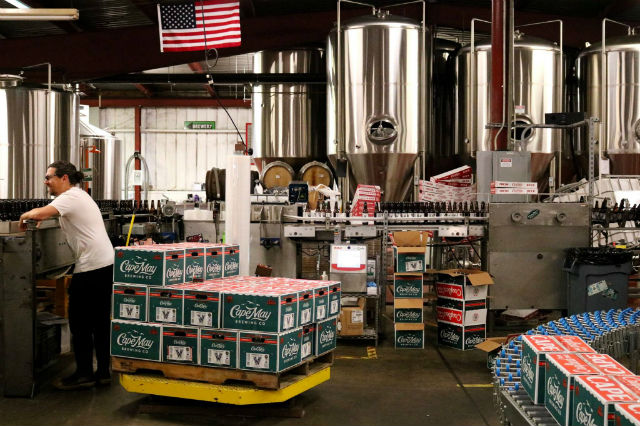
Cape May Brewing installed a malt silo in 2015 when they moved into their newest facility. It was a big change from the first four years as the brewery grew. It started with a 12-gallon brewhouse and now touts a 30-barrel facility, so malt storage needs have changed.
Jimmy Valm, the Director of Brewing Operations for the New Jersey brewery discussed malt storage with Brewer for an upcoming story about when to purchase silos in the March/April issue of Brewer.
So many great breweries responded to questions asked that we feel that all the stories should be shared and Brewer will release the Q&As throughout the next few weeks. Thank you to all the breweries that shared their insights.
BREWER: As your brewery has grown, what sort of steps have been taken to improve the logistics and efficiency in ordering malt? (Going from bags, to pallets, to trucks, etc.)
VALM: At first, it was very easy to predict how much malt we needed, we had a 12 gallon brewhouse so, we never needed too much, and malt has a decent shelf-life so we could order a fair amount and just watch the stack get lower and lower and anticipate when more would be needed. When we upgraded to a 15-barrel brewhouse, one of our guys designed an Excel file that we could enter in our recipes and then build out a schedule a week or two in advance and it would predict our malt inventory into the future. Going more than a week or two in advance was tough, though, because at that time the plans would change so frequently that if one were to go any further it would just create more work when they had to inevitably change the plans again. Since we moved to our new 30-bbl facility, we installed a program called Ekos that acts as a production, inventory, and sales tracker; we can more easily build in a production schedule into this as well as purchase orders and sales invoices, so the user interface is much better and allows us to plan our production 4-5 weeks in advance, which gives us a much better idea of what we will need and when. And most recently, we have begun forecasting sales a year in advance, so now we can also negotiate contracts with our suppliers; this gives them a better idea of what we will need so we know it’ll always be available. We also started contracting for some of our more common specialty malts as well, which gives us a much better price on them, too, saving the company a few thousand dollars each year. Contracting is great, but you really need to have a game-plan for your business well in advance so it’s reliable.
BREWER: How has malt storage on site changed for you as you have grown?
VALM: When we first opened we were buying malt one or two bags at a time. We had a 12-gallon system so we didn’t need anymore than that. And, as we grew we started ordering mixed pallets (which many supplier accommodate for) and eventually got to where we were ordering full pallets of our base malts and commonly used specialty malts. When we moved into our new facility in 2015 we installed a new 30-bbl brewhouse, along with this went a single malt silo for our base malt. Nowadays we still use the one silo, although we have kicked around the idea of installing a second one for easier production needs, that way we wouldn’t need to so tightly schedule in when our deliveries arrive (our silo can hold 60,000 pounds and each delivery is about 48,000 pounds, so it needs to be almost empty before we can accept a delivery); this would enable us to run out of one silo until it is empty, then just switch over to the other one which would mean we have a wider window for receiving deliveries, but it would also mean we empty out the silos more often and therefore the grain chaff doesn’t build up as much.
BREWER: Do you have a base malt for the majority of your brands? Was that always the case? Did your portfolio change at all to be able to have a more bulk order of one base malt?
VALM: We have one base malt that we use for all of our beers except for one or two (out of around 100 we’ll brew in a given year), this has always been the case; we made sure to go with a malt that was available in bags, supersacks, and bulk deliveries, so we could get it in any form we needed no matter what our size was so our recipes wouldn’t need to change.
BREWER: How did you factor in things like weather, logistics and other such things when figuring out new storage areas?
VALM: It’s best to have any malt storage in an area that is accessible for easy clean-up as this area is usually where you’ll have your greatest pest problems, so you want it to be separate and easily cleaned after each milling or at least once per day. Most breweries, including ours, are in large open buildings so things like climate control are going to be the same throughout, but if you can keep it away from heat sources, that would be best as the warmer the malt is the shorter its shelf-life would be, and also malt dust is very explosive, so you’d want to avoid that. That being said, it’d be even better if malt storage and mills and grist cases can be in their own room to prevent malt dust from spreading to other areas, which also makes clean up easier, too. Lastly, since most malt being used in coming in on pallets of 50-55 pound bags, it’d be best to have it easily accessible from loading bays, no one wants to lug around 40 bags of malt from one end of a building to another, and even if there’s room for a forklift now, there may not be later on, and it’s easier to set it up right the first time than to move one’s milling system. When we moved into our new facility we had to put the malt silo near the back loading area so it could be accessed by trucks for unloading their delivery, we also wanted to put our mill (and therefore other malt storage) just inside from this so the auger coming from the malt silo was as short as possible since long auger lines can break up the malt before it gets milled, which isn’t good because you want the mill to crush the malt in a manner that you have controlled, not by the auger in random ways.
Read more about silos and malt storage in the March/April issue of Brewer Magazine.






2 Trackbacks / Pingbacks